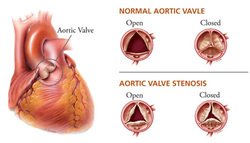Medicine Notes - Clinical Examination - Aortic Stenosis

Aortic Stenosis
Aortic stenosis usually cause by congenital calcification bicuspid aortic valve which present early in life. Aortic stenosis is also related to rheumatic fever.
Aortic stenosis may present with low volume and slow rising pulses. There will be reduction in pulse pressure. The apex beat is heaving due to pressure overload but the apex beat is not displaced. Thrill is commonly fell in the aortic area mostly in young and thin patient.
Aortic stenosis may present with harsh, ejection systolic murmur over the aortic area or in the seatbelt distribution. Patient with aortic stenosis may present with quiet second heart sound. The systolic ejection murmur may radiates into the carotid.
The common complications of aortic stenosis are syncope, angina and cardiac failure. Cardiovascular collapse may occur due to drop in preload ( due to the intake of nitrate). Drop in preload may lead to reduction in stroke volume and stretch of the ventricles which finally lead to reduction in pressure and collapse of the cardiovascular system.
Aortic stenosis usually cause by congenital calcification bicuspid aortic valve which present early in life. Aortic stenosis is also related to rheumatic fever.
Aortic stenosis may present with low volume and slow rising pulses. There will be reduction in pulse pressure. The apex beat is heaving due to pressure overload but the apex beat is not displaced. Thrill is commonly fell in the aortic area mostly in young and thin patient.
Aortic stenosis may present with harsh, ejection systolic murmur over the aortic area or in the seatbelt distribution. Patient with aortic stenosis may present with quiet second heart sound. The systolic ejection murmur may radiates into the carotid.
The common complications of aortic stenosis are syncope, angina and cardiac failure. Cardiovascular collapse may occur due to drop in preload ( due to the intake of nitrate). Drop in preload may lead to reduction in stroke volume and stretch of the ventricles which finally lead to reduction in pressure and collapse of the cardiovascular system.
